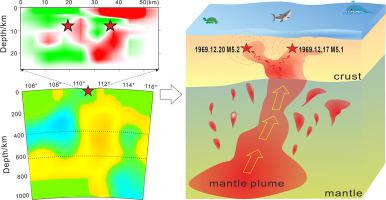Gondwana Research ( IF 7.2 ) Pub Date : 2021-11-23 , DOI: 10.1016/j.gr.2021.10.029 Jiangnan Lin 1, 2 , Shaohong Xia 1, 3 , Xinyang Wang 1, 3 , Dapeng Zhao 4 , Dawei Wang 5

|
Mantle plumes are one of the most influential first-order tectonic systems on Earth, playing a prominent role in controlling local magmatic activity and seismicity. Recent studies have shown that the Hainan mantle plume originates from the lower mantle and its volcanic activity is still intense during the Holocene. However, the effect of the Hainan plume on local seismicity is still unclear. In this study, we conducted the first wide-angle seismic survey in the source area of the 1969 earthquake doublet (M 5.1 and 5.2) offshore Hainan Island. A high-resolution 3-D P-wave velocity model of the crust is obtained using a large amount of Pg and PmP arrival times recorded by a portable array consisting of 17 ocean bottom seismographs (OBSs). Our results show that the 1969 earthquake doublet occurred in high-to-low velocity transitional zones which correspond to active faults. Prominent low-velocity anomalies are revealed in the crust of the study area, which may reflect magmatic intrusion channels. On the basis of multiple geophysical evidence including multi-channel seismic reflection profiles, geothermal data, and seismic tomography results, we infer that the low-velocity anomalies in the source area may reflect magmas and fluids from the Hainan plume, and high-angle normal faults in the crust serve as conduits for ascending of the magmas and fluids. The 1969 earthquake doublet offshore Hainan Island can be attributed to the magma-hydrothermal alteration processes in the fault zones, which led to the significant reduction of the fault strength and friction coefficient, facilitating the shear failure propagation. Furthermore, the seismicity in and around Hainan Island exhibits distinct swarm-like behaviors, which is also evidence for the Hainan plume affecting the crustal seismicity.
中文翻译:

受海南地幔柱影响的地震地壳结构
地幔柱是地球上最具影响力的一级构造系统之一,在控制当地岩浆活动和地震活动方面发挥着重要作用。最近的研究表明,海南地幔柱起源于下地幔,在全新世期间其火山活动仍然强烈。然而,海南羽流对当地地震活动的影响尚不清楚。在这项研究中,我们在海南岛近海 1969 年双震(M 5.1 和 5.2)震源区进行了第一次广角地震勘测。使用由 17 个海底地震仪 (OBS) 组成的便携式阵列记录的大量 Pg 和 PmP 到达时间,获得了地壳的高分辨率 3-D P 波速度模型。我们的研究结果表明,1969 年的双震发生在与活动断层相对应的高低速过渡带。研究区地壳显示出明显的低速异常,这可能反映了岩浆侵入通道。根据多道地震反射剖面、地热资料、地震层析成像等多种地球物理证据,我们推断源区低速异常可能反映了海南羽流的岩浆和流体,以及高角度法线地壳中的断层是岩浆和流体上升的通道。1969年海南岛近海双重地震,可归因于断裂带岩浆-热液蚀变过程,导致断裂强度和摩擦系数显着降低,促进剪切破坏传播。此外,海南岛及其周边的地震活动表现出明显的群状行为,这也是海南羽流影响地壳地震活动的证据。





















































 京公网安备 11010802027423号
京公网安备 11010802027423号